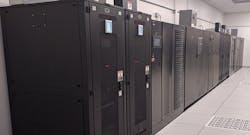Energy Storage: Lead Acid Versus Lithium-Ion Batteries
This is the first entry in a four-part Data Center Frontier Special Report Series, in partnership with Liion, that explores the future of lithium-ion batteries and their impact on energy storage. This first entry offers a comparison of the capabilities and characteristics of lead acid versus lithium-ion batteries.
Download the full report.
In most data center facilities, lead acid batteries are the standard stored energy source for UPSs, providing brief ride-through time during a changeover to an auxiliary power source, or providing time for an orderly shutdown. Data centers depend on their UPSs and associated battery backups to provide continuity of their critical systems during a power outage. But lead-acid batteries have numerous disadvantages, including:
Reliability
UPSs are typically powered by strings of lead acid batteries, and any individual battery could be a point of failure. A single bad battery cell can bring down a data center’s entire backup system, especially if the facility hasn’t established UPS redundancy.
A 2013 Ponemon Research study found that lead acid battery failure is the most frequent cause of unplanned data center outages, beating out other causes such as human error, exceeding UPS capacity, cyber attacks, bad weather incidents, etc. The study found that 55% of unplanned outages, and one-third of all UPS system failures, were related to lead acid battery failure.
A 2013 Ponemon Research study found that 55% of unplanned outages, and one-third of all UPS system failures, were related to lead acid battery failure.
Lifespan
Lead acid batteries must be replaced every 4-5 years, or three to four times over the 15-year life of a UPS system. The cost of replacement batteries and the time and labor involved increases their total cost of ownership (TCO). Service life is dictated by how often batteries are discharged and recharged. But factors like overcharging, frequent discharge cycles, high or uneven room temperatures, strained battery terminals, and loose intercell connections can shorten a battery’s useful life.
Size and Weight
A lead acid battery cabinet takes up considerable floor space that might otherwise be used for IT infrastructure. Also, lead acid batteries are heavy, and can literally “weigh down” a data center. In some facilities, floors may need to be reinforced to handle the extra weight of lead acid battery systems.
Maintenance
Facility managers and technicians must continuously evaluate individual lead acid batteries through ongoing voltage checks and performance monitoring, to ensure that a single bad battery doesn’t take down an entire string. Data centers must do frequent maintenance to remove corrosion, prevent loose connections, and identify and replace defective batteries.
Cooling Requirements
Lead acid batteries require a controlled room temperature of around 77°F (25°C) to keep your warranty and ensure 3 to 5 years of life. The cost of cooling battery rooms or cabinets adds to their TCO. Also, lead acid batteries are sensitive to temperature changes. Every 10°C the room temperature goes up, it reduces the battery’s useful life.
Environmental Hazard
Lead acid batteries contain large amounts of highlytoxic lead and sulfuric acid, both of which are hazardous to the environment. Recycling of lead acid batteries is considered one of the worst polluting industries in the world.
Lead Acid vs. Lithium-Ion Batteries
The table below compares the performance of lead acid batteries vs. lithium-ion batteries (using the lithium iron phosphate chemistry as an example):
In the coming weeks, the special report series will also cover the following topics:
- Lithium-Ion Batteries Lead to TCO Savings for Energy Storage
- Additional Data Center Applications for Lithium-Ion Batteries
- Lithium Iron Phosphate – The Ideal Chemistry for UPS Batteries
Download the full report, “Why Lithium-Ion Batteries are the Future of UPS Energy Storage for Data Centers and Colocation Facilities,” courtesy of Liion, to lean more about the potential of lithium-ion batteries.


